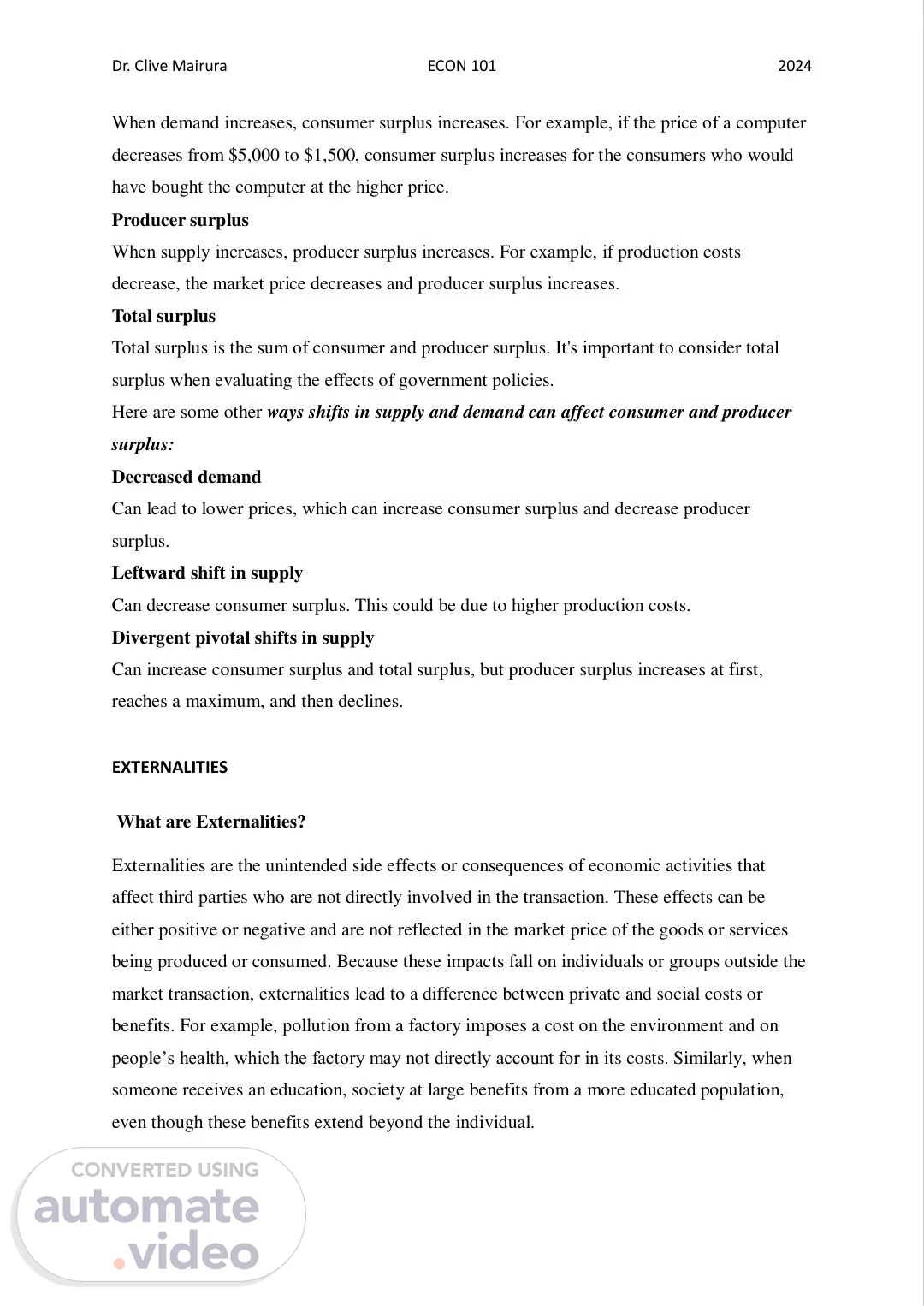Scene 1 (0s)
Dr. Clive Mairura ECON 101 2024 When demand increases, consumer surplus increases. For example, if the price of a computer decreases from $5,000 to $1,500, consumer surplus increases for the consumers who would have bought the computer at the higher price. Producer surplus When supply increases, producer surplus increases. For example, if production costs decrease, the market price decreases and producer surplus increases. Total surplus Total surplus is the sum of consumer and producer surplus. It's important to consider total surplus when evaluating the effects of government policies. Here are some other ways shifts in supply and demand can affect consumer and producer surplus: Decreased demand Can lead to lower prices, which can increase consumer surplus and decrease producer surplus. Leftward shift in supply Can decrease consumer surplus. This could be due to higher production costs. Divergent pivotal shifts in supply Can increase consumer surplus and total surplus, but producer surplus increases at first, reaches a maximum, and then declines. EXTERNALITIES What are Externalities? Externalities are the unintended side effects or consequences of economic activities that affect third parties who are not directly involved in the transaction. These effects can be either positive or negative and are not reflected in the market price of the goods or services being produced or consumed. Because these impacts fall on individuals or groups outside the market transaction, externalities lead to a difference between private and social costs or benefits. For example, pollution from a factory imposes a cost on the environment and on people’s health, which the factory may not directly account for in its costs. Similarly, when someone receives an education, society at large benefits from a more educated population, even though these benefits extend beyond the individual..
Scene 2 (1m 5s)
Dr. Clive Mairura ECON 101 2024 How Negative and Positive Externalities Lead to Market Failure. Explain How Government Policies Like Taxes, Subsidies, or Regulation Can Correct These Market Failures, Using Examples. Negative Externalities and Market Failure A negative externality occurs when an economic activity imposes a cost on third parties. For example, pollution from manufacturing industries can harm the environment and public health, even though people nearby are not part of the transaction. This results in a higher social cost than the private cost incurred by the producer. Because these external costs are not included in the market price, goods with negative externalities tend to be overproduced, leading to market failure, where the outcome is not socially optimal. Example: A factory emitting air pollution incurs private production costs but not the additional costs to society, such as health impacts or environmental damage. Thus, the factory may produce more than what is socially optimal. Government Correction: o Taxes: To internalize these external costs, governments can impose a tax on the polluting firm. This is known as a “Pigouvian tax,” which aims to align the private cost of production with the social cost. For example, a carbon tax on emissions makes firms pay more for polluting, encouraging them to reduce emissions or adopt cleaner technology. o Regulation: Governments can set pollution limits or emission standards. For example, environmental regulations may restrict the allowable emissions from factories, ensuring that production is kept within environmentally safe limits. Positive Externalities and Market Failure A positive externality occurs when an activity generates benefits for third parties. Education, for instance, not only benefits the individual receiving it but also society, as it leads to a more skilled and productive workforce. Because the market does not capture these external benefits, goods and services with positive externalities tend to be underproduced, resulting in market failure where the socially optimal quantity is not achieved. Example: Individuals who invest in flu vaccinations not only protect themselves but also reduce the spread of illness in the community. However, because individuals do not account for these broader benefits, fewer people may get vaccinated than is optimal for public health. Government Correction:.
Scene 3 (2m 10s)
Dr. Clive Mairura ECON 101 2024 o Subsidies: The government can provide subsidies to encourage consumption or production of goods with positive externalities. For instance, subsidizing flu vaccines lowers the cost for individuals, leading to a higher vaccination rate and greater public health benefits. o Public Provision: In some cases, the government may provide the good directly, as with public education, to ensure that a larger portion of the population has access to it, capturing the positive social effects of an educated society. Summary Negative externalities lead to overproduction, while positive externalities lead to underproduction. By implementing taxes on goods with negative externalities and subsidies or direct provision for goods with positive externalities, governments can shift production and consumption closer to the socially optimal level, thereby reducing or correcting market failure..
